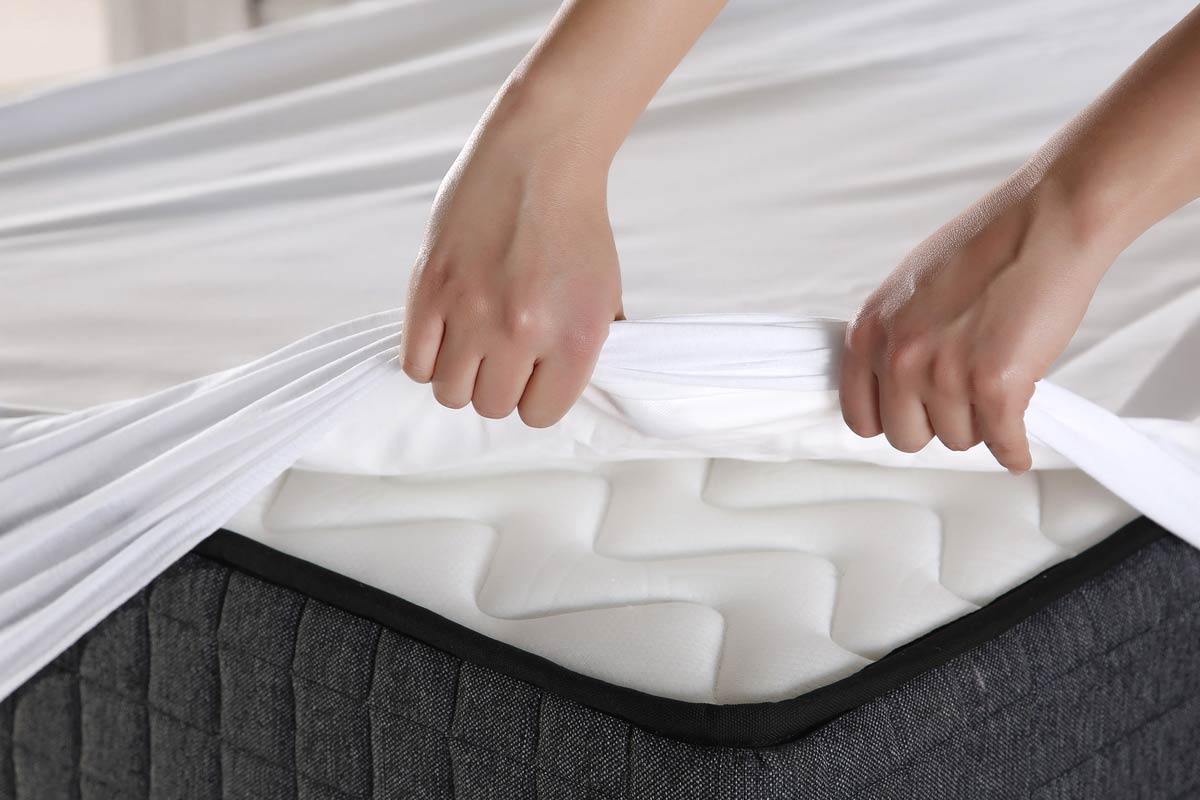If you've ever moved or flipped your mattress, you may have wondered if it's possible to put it back on your bed upside down. After all, mattresses are heavy and can be difficult to maneuver, so why not save some time and effort by just flipping it over? However, this seemingly simple solution may actually have negative consequences for your sleep and the longevity of your mattress. In this article, we'll delve into the question of whether a mattress can be upside down and what you should do if you accidentally put it in the wrong position.Can a Mattress Be Upside Down?
Before we get into the potential problems of sleeping on an upside down mattress, let's first figure out how to tell if your mattress is indeed upside down. One way to do this is by checking the labeling on your mattress. Many mattresses have a label indicating which side should be facing up for optimal comfort and support. If your mattress does not have a label or the label has faded over time, there are a few other ways to determine if it's upside down. First, you can check for any signs of wear or sagging. If the side you are currently sleeping on is more worn or sagging, then it's likely that you have been sleeping on the upside down side. You can also try lying on different sides of the mattress and see which feels more comfortable. If you have been sleeping on the upside down side, you may notice a difference in comfort and support when lying on the correct side.How to Tell if Your Mattress is Upside Down
Sleeping on an upside down mattress can have negative consequences for both your sleep and the longevity of your mattress. First and foremost, it can affect your comfort and support while you sleep. Most mattresses are designed to have a specific side facing up in order to provide the best support for your body. Sleeping on the wrong side can lead to discomfort and even pain in the long term. In addition, sleeping on an upside down mattress can also cause premature wear and tear. This is because the side that is meant to be facing down is not getting the proper support and rotation, leading to uneven wear and potentially causing the mattress to sag or become lumpy.What Happens if You Sleep on a Mattress Upside Down?
Now that we've established the importance of having your mattress in the correct position, you may be wondering if you can just flip it over instead of rotating it. The answer to this question depends on the type of mattress you have. For traditional innerspring mattresses, flipping them over is possible and recommended every 3-6 months to promote even wear. However, for memory foam or hybrid mattresses, flipping is not recommended as they are designed to have one specific side facing up.Can You Flip a Mattress Over?
Properly rotating and flipping your mattress is essential for maintaining its longevity and comfort. If you have a traditional innerspring mattress, flip it over every 3-6 months and rotate it 180 degrees every 3 months. This will ensure even wear and prolong the life of your mattress. For memory foam or hybrid mattresses, you should rotate them 180 degrees every 3 months to promote even wear. However, flipping them over is not recommended as the layers and materials are designed to work in a specific way and may be damaged if flipped.How to Properly Rotate and Flip Your Mattress
As we've mentioned, sleeping on an upside down mattress can have negative consequences for your sleep and the longevity of your mattress. Not only will it be less comfortable and supportive, but it can also lead to premature wear and tear, shortening the lifespan of your mattress. This can result in you needing to replace your mattress sooner and spending more money in the long run.Why You Shouldn't Sleep on an Upside Down Mattress
If you accidentally put your mattress upside down, don't panic. The first thing you should do is check the label to see which side should be facing up. If there is no label, try lying on both sides and see which feels more comfortable and supportive. If necessary, rotate and flip your mattress according to the guidelines mentioned above. If you notice any sagging or discomfort after sleeping on the wrong side, you may need to invest in a new mattress. It's important to prioritize your comfort and health, and a good quality mattress is essential for a good night's sleep.What to Do if You Accidentally Put Your Mattress Upside Down
If you notice that your mattress is sagging, it may be due to sleeping on it upside down or not rotating it regularly. In this case, you can try flipping and rotating the mattress to see if it helps. If the sagging persists, you may need to replace your mattress. It's important to address a sagging mattress as it can cause discomfort and disrupt your sleep.How to Fix a Sagging Mattress
Proper mattress maintenance, including rotating and flipping, is crucial for maintaining the comfort and longevity of your mattress. It's important to follow the guidelines provided by the manufacturer and to regularly check for any signs of wear or sagging. By taking care of your mattress, you can ensure a comfortable and supportive sleep for years to come.The Importance of Proper Mattress Maintenance
Even with proper maintenance, mattresses will eventually need to be replaced. The average lifespan of a mattress is 7-10 years, but this may vary depending on the type and quality of your mattress, as well as your individual sleep habits. If you notice significant wear or sagging, it may be time to invest in a new mattress for optimal comfort and support. In conclusion, while it may seem tempting to just flip your mattress over and save some time, it's important to resist the urge and prioritize proper mattress maintenance. Sleeping on an upside down mattress can have negative consequences for your sleep and the longevity of your mattress. By following the guidelines provided and regularly checking for signs of wear, you can ensure a comfortable and supportive sleep for years to come.When to Replace Your Mattress
Why You Should Consider Flipping Your Mattress Upside Down

The Importance of Mattress Maintenance
 When it comes to house design, every detail matters. From the color of the walls to the type of furniture, everything contributes to creating a comfortable and aesthetically pleasing living space. However, one important aspect that is often overlooked is the maintenance of our mattresses. We spend a third of our lives sleeping, so it's essential to have a clean, supportive, and comfortable mattress to promote a good night's rest.
But did you know that flipping your mattress can also play a significant role in its maintenance?
When it comes to house design, every detail matters. From the color of the walls to the type of furniture, everything contributes to creating a comfortable and aesthetically pleasing living space. However, one important aspect that is often overlooked is the maintenance of our mattresses. We spend a third of our lives sleeping, so it's essential to have a clean, supportive, and comfortable mattress to promote a good night's rest.
But did you know that flipping your mattress can also play a significant role in its maintenance?
The Pros of Flipping Your Mattress
 Flipping your mattress upside down may seem like an odd suggestion, but it has many benefits. Firstly, it helps to evenly distribute the weight and pressure on the mattress, preventing it from sagging in certain areas. This, in turn, prolongs the lifespan of your mattress, saving you money in the long run.
Flipping your mattress also allows the materials inside to settle and reshape, ensuring a more comfortable and supportive surface to sleep on.
Additionally, flipping your mattress can help to prevent allergens and dust mites from accumulating on one side, as well as reduce the risk of mold or mildew growth.
Flipping your mattress upside down may seem like an odd suggestion, but it has many benefits. Firstly, it helps to evenly distribute the weight and pressure on the mattress, preventing it from sagging in certain areas. This, in turn, prolongs the lifespan of your mattress, saving you money in the long run.
Flipping your mattress also allows the materials inside to settle and reshape, ensuring a more comfortable and supportive surface to sleep on.
Additionally, flipping your mattress can help to prevent allergens and dust mites from accumulating on one side, as well as reduce the risk of mold or mildew growth.
How to Flip Your Mattress
 Now that you know the benefits of flipping your mattress, let's discuss how to do it correctly. The first step is to check if your mattress is suitable for flipping. Some mattresses, such as memory foam or pillow-top, are designed to only be used on one side and cannot be flipped.
It is essential to follow the manufacturer's instructions to avoid damaging your mattress.
If your mattress is suitable for flipping, the next step is to rotate it 180 degrees so that the head is now at the foot of your bed. Then, carefully lift and flip the mattress over, ensuring that it is aligned correctly on your bed frame.
Now that you know the benefits of flipping your mattress, let's discuss how to do it correctly. The first step is to check if your mattress is suitable for flipping. Some mattresses, such as memory foam or pillow-top, are designed to only be used on one side and cannot be flipped.
It is essential to follow the manufacturer's instructions to avoid damaging your mattress.
If your mattress is suitable for flipping, the next step is to rotate it 180 degrees so that the head is now at the foot of your bed. Then, carefully lift and flip the mattress over, ensuring that it is aligned correctly on your bed frame.
When to Flip Your Mattress
 The frequency of flipping your mattress depends on the type and condition of the mattress. Generally, it is recommended to flip your mattress every six months to maintain its shape and support. However, if you notice any sagging, unevenness, or discomfort, consider flipping it more frequently.
It is also a good idea to flip your mattress after deep cleaning it, as this will help to evenly distribute any cleaning products or moisture that may have been used.
In conclusion, while flipping your mattress may seem like a small and insignificant task, it can have a significant impact on its maintenance and longevity. By following the proper techniques and considering the type and condition of your mattress, you can enjoy a cleaner, more comfortable, and supportive sleeping surface for years to come. So, next time you wonder if a mattress can be upside down, remember the benefits it can bring and give it a try.
The frequency of flipping your mattress depends on the type and condition of the mattress. Generally, it is recommended to flip your mattress every six months to maintain its shape and support. However, if you notice any sagging, unevenness, or discomfort, consider flipping it more frequently.
It is also a good idea to flip your mattress after deep cleaning it, as this will help to evenly distribute any cleaning products or moisture that may have been used.
In conclusion, while flipping your mattress may seem like a small and insignificant task, it can have a significant impact on its maintenance and longevity. By following the proper techniques and considering the type and condition of your mattress, you can enjoy a cleaner, more comfortable, and supportive sleeping surface for years to come. So, next time you wonder if a mattress can be upside down, remember the benefits it can bring and give it a try.






















































































































